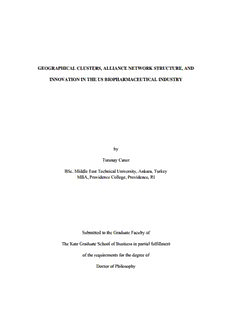Table Of ContentGEOGRAPHICAL CLUSTERS, ALLIANCE NETWORK STRUCTURE, AND
INNOVATION IN THE US BIOPHARMACEUTICAL INDUSTRY
by
Turanay Caner
BSc. Middle East Technical University, Ankara, Turkey
MBA, Providence College, Providence, RI
Submitted to the Graduate Faculty of
The Katz Graduate School of Business in partial fulfillment
of the requirements for the degree of
Doctor of Philosophy
UNIVERSITY OF PITTSBURGH
Katz Graduate School of Business
This dissertation was presented
by
Turanay Caner
It was defended on
February 26, 2007
and approved by
Dissertation Advisor: John E. Prescott, Ph.D.
The Thomas O’Brien Chair of Strategy, University of Pittsburgh
Ravindranath Madhavan, Ph.D.
University of Pittsburgh
Susan K. Cohen, Ph.D.
University of Pittsburgh
John Hulland, Ph.D.
University of Pittsburgh
Balaji Koka, Ph.D.
Arizona State University
ii
COMMITTEE SIGNATURE PAGE
John E. Prescott, Ph.D.
The Thomas O’Brien Chair of Strategy
Dissertation Advisor
Katz Graduate School Business
University of Pittsburgh
Ravindranath Madhavan, Ph.D.
Katz Graduate School Business
University of Pittsburgh
Susan K. Cohen, Ph.D.
Katz Graduate School Business
University of Pittsburgh
John Hulland, Ph.D.
Katz Graduate School Business
University of Pittsburgh
Balaji Koka, Ph.D.
W.P. Carey School of Business
Arizona State University
iii
Copyright © by Turanay Caner
2007
iv
GEOGRAPHICAL CLUSTERS, ALLIANCE NETWORK STRUCTURE, AND
INNOVATION IN THE US BIOPHARMACEUTICAL INDUSTRY
Turanay Caner, PhD
University of Pittsburgh, 2007
Abstract
I examine the effects of firms’ cluster membership on their alliance network structure, and how
firms’ absorptive capacity moderates the relationship between alliance network structure and
innovation. Little is known regarding the inter-relationship between cluster membership,
network structure and innovation. This study bridges this gap by first establishing the
endogenous nature of network structure with respect to cluster membership and then by studying
the moderating effect of absorptive capacity for the alliance network structure and innovation
relationship.
I contribute to the strategic management literature in several important ways. First, I
clarify the implications of cluster membership on network structure by including two competing
explanations: complementary and substitution mechanisms. Contrary to the popular belief that
cluster membership does not matter, I find that it does matter in the study of the US
biopharmaceutical industry. My findings show that firms’ location within a cluster area does not
v
substitute for their strategic choices specifically for their alliance strategies. Second, I
theoretically argue and then empirically demonstrate that network structure is an endogenous
phenomenon with respect to cluster membership. Third, I demonstrate that when controlled for
endogeneity with respect to cluster membership, alliance network structure and innovation
relationship is positively moderated by firms’ absorptive capacity. In contrast to prior literature,
I find that the main effect of firms’ structural holes on innovation is not significant when
controlled for endogeneity. This finding is important given the mixed findings for structural
holes and innovation relationship in previous studies. Finally, to the best of my knowledge, in
the strategic management literature this study is the first study to introduce an exponential
regression model with Generalized Methods of Moments (GMM) estimation that accounts for
both the endogenous nature of independent variables and the count nature of dependent variable.
vi
TABLE OF CONTENTS
ACKNOWLEDGEMENTS.......................................................................................................XIII
DEDICATION.............................................................................................................................XV
1.0 INTRODUCTION .........................................................................................................1
1.1 OVERVIEW..........................................................................................................1
1.2 RESEARCH QUESTIONS...................................................................................3
1.3 THEORETICAL PERSPECTIVES AND MOTIVATION..................................4
1.4 RESEARCH DESIGN...........................................................................................7
1.4.1 Research Context and Data.............................................................................7
1.4.2 Econometric Analysis.....................................................................................8
1.4.3 Results.............................................................................................................9
1.5 CONTRIBUTION...............................................................................................10
2.0 LITERATURE REVIEW AND HYPOTHESES DEVELOPMENT..........................13
2.1 BACKGROUND.................................................................................................13
2.2 THEORY AND HYPOTHESES DEVELOPMENT..........................................16
2.2.1 Cluster Membership and Alliance Network Structure..................................16
2.2.1.1 Cluster membership and centrality.......................................................16
2.2.1.2 Cluster membership and structural holes..............................................21
vii
2.2.2 The endogenous alliance network structure with respect to cluster
membership and innovation relationship: Absorptive capacity as a moderator.........24
2.2.2.1 Centrality and absorptive capacity........................................................26
2.2.2.2 Structural holes and absorptive capacity..............................................28
3.0 METHODS..................................................................................................................30
3.1 RESEARCH CONTEXT AND DATA COLLECTION.....................................30
3.2 CLUSTER IDENTIFICATION...........................................................................33
3.3 MEASURES........................................................................................................34
3.3.1 Independent variable.....................................................................................34
3.3.1.1 Cluster membership..............................................................................34
3.3.2 Network structure variables..........................................................................35
3.3.2.1 Centrality..............................................................................................36
3.3.2.2 Structural Holes....................................................................................36
3.3.3 Moderator variable........................................................................................37
3.3.3.1 Absorptive Capacity.............................................................................37
3.3.4 Interaction Variables.....................................................................................38
3.3.5 Dependent Variable......................................................................................38
3.3.5.1 Innovation.............................................................................................38
3.3.6 Control Variables..........................................................................................39
3.3.6.1 Firm size...............................................................................................39
3.3.6.2 Firm age................................................................................................39
3.3.6.3 Indirect ties...........................................................................................40
3.3.6.4 Time (year effects)................................................................................40
viii
3.4 SAMPLE CHARACTERISTICS........................................................................41
4.0 ANALYSIS..................................................................................................................43
5.0 RESULTS....................................................................................................................48
5.1 FINDINGS...........................................................................................................48
5.2 INTERPRETATION OF FINDINGS..................................................................54
6.0 DISCUSSION AND CONCLUSION..........................................................................57
6.1 DISCUSSION AND IMPLICATIONS...............................................................57
6.2 LIMITATIONS AND FUTURE RESEARCH...................................................63
APPENDIX...................................................................................................................................80
BIBLIOGRAPHY.......................................................................................................................118
ix
LIST OF TABLES
Table 1. A Summary of Hypothesized Relationships in the Study..............................................71
Table 2. Variable Labels and Definitions....................................................................................72
Table 3. Geographic Summary of Sample...................................................................................73
Table 4. Sample characteristics based on In-Cluster and Out-Cluster Firms..............................74
Table 5. Summary Statistics and Correlations for the period 1998- 2004...................................75
Table 6. Hypothesis 1: Cluster membership and centrality relationship....................................76
Table 7. Hypothesis 2: Cluster membership and structural holes relationship...........................77
Table 8. Hypothesis 3: Centrality and patent relationship..........................................................78
Table 9. Hypothesis 4: Structural holes and patent relationship.................................................79
Table 10. Sample Distribution based on In and Out Cluster Identification.................................81
Table 11. Biopharmaceutical Cluster in the US...........................................................................87
Table 12. Correlation Table for Firm Attributes..........................................................................89
Table 13. The relationship between Firm Characteristics and Cluster Membership...................90
Table 14. Comparison of this study with a prior study by Ahuja (2000)..................................106
Table 15. Determinants of R&D Intensity in the Biopharmaceutical Industry.........................107
x
Description:GEOGRAPHICAL CLUSTERS, ALLIANCE NETWORK STRUCTURE, AND INNOVATION IN THE US BIOPHARMACEUTICAL INDUSTRY . Turanay Caner, PhD . University of Pittsburgh, 2007

